Affiliate disclosure: This post may contain affiliate links. Please see our Privacy Policy.
Dehydrating pineapple is easy, only requiring minimal prep before the food goes into the dehydrator (or oven). You’ll be snacking on delicious dried pineapple before you know it!
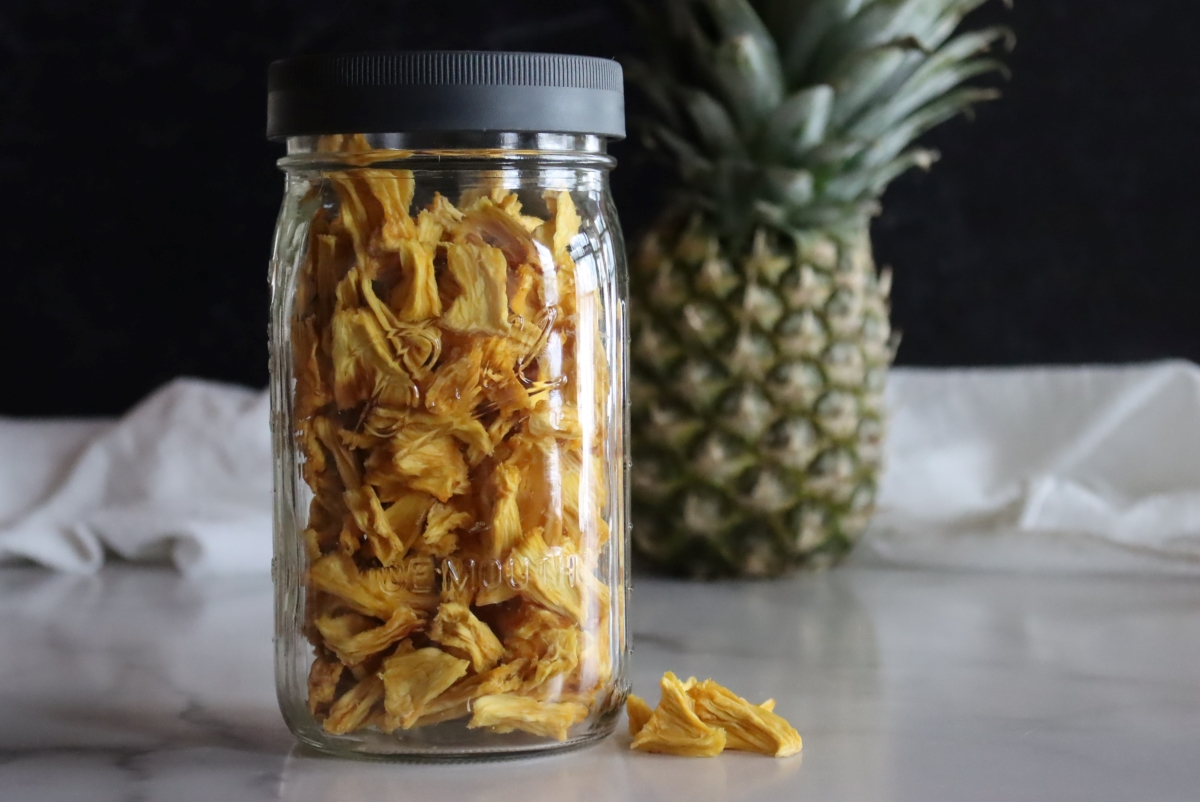
Dried pineapple is a delicious snack, and it’s the perfect shelf-stable tropical treat.
Most of the food we preserve here is simple food we grow at home, but I make an exception for pineapple. It’s one of my very favorite fruits, and a good way to experience the taste of the tropics (even here in Vermont).
Pineapples are expensive much of the year, and I just can’t stomach paying $6 or $7 each. But come April/May, it’s pineapple season and they’re about a dollar or two apiece. I’ll stock up on a year’s worth of pineapple, bringing home literally cases of tasty tropical fruit for preserving.
This time of year you’ll find me canning pineapple chunks, pineapple jam, and even making pineapple wine.
Sometimes though, you just want a quick tasty snack without getting sticky, and dried pineapple is perfect for that. It’s clean, delicious, and perfect for packing in lunches, taking on the trail, or just sneaking a quick snack right in the pantry.
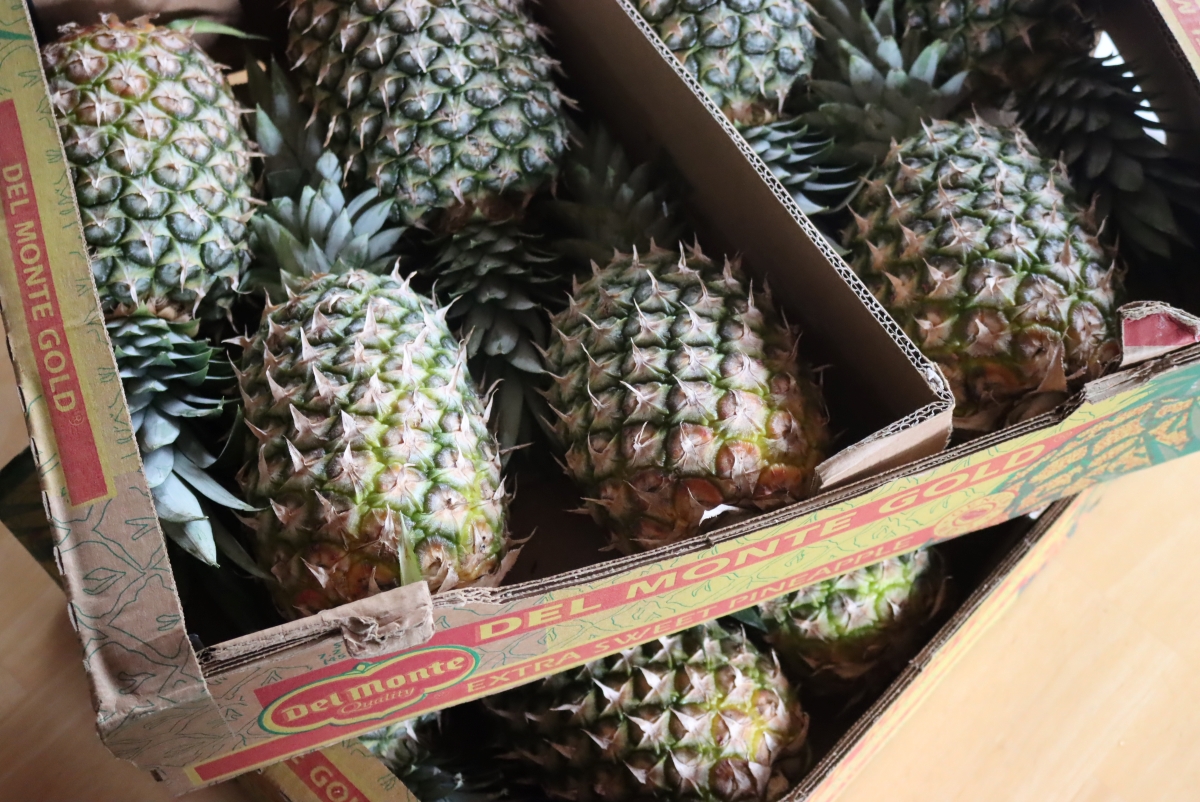
Choosing Pineapple for Dehydrating
My friend Chris just wrote a whole book on dehydrating for beginners, where she covers all the basics of dehydrating just about everything under the sun, including dehydrating pineapple. Her page on making dried pineapple suggests:
“Pineapples are a sweet addition to trail mix, granola, muffins, and breads. When choosing a ripe pineapple, look for fresh, glossy leaves. The skin should be yellowish-brown and the fruit should be free of mold or gray areas around the stem end. A fully ripe pineapple will smell fruity and sweet near the base; if the pineapple is scentless or smells “off,” look for a better candidate.”
I’ll add that you can also dehydrate canned pineapple, and some people actually prefer it that way.
Preparing Pineapple for Dehydrating
The first choice here is shape. If you’re working with fresh pineapple, then you have the option to cut it any way you like. Some people like whole pineapple rings, as they look nice in a bag (and it’s obviously pineapple, so a good option for picky kids who need that visual confirmation).
Personally, I like small chunks of dried pineapple. They dehydrate faster that way, and they’re more versatile. I can throw them into trail mix, muffins, or whatever. If I have rings, I can always cut them down later of course, but they’re really only good for snacking as-is unless I do more prep work.
I make chunks of pineapple, about 1 to 1 1/2 inches long, by about 1/2 inch wide/thick.
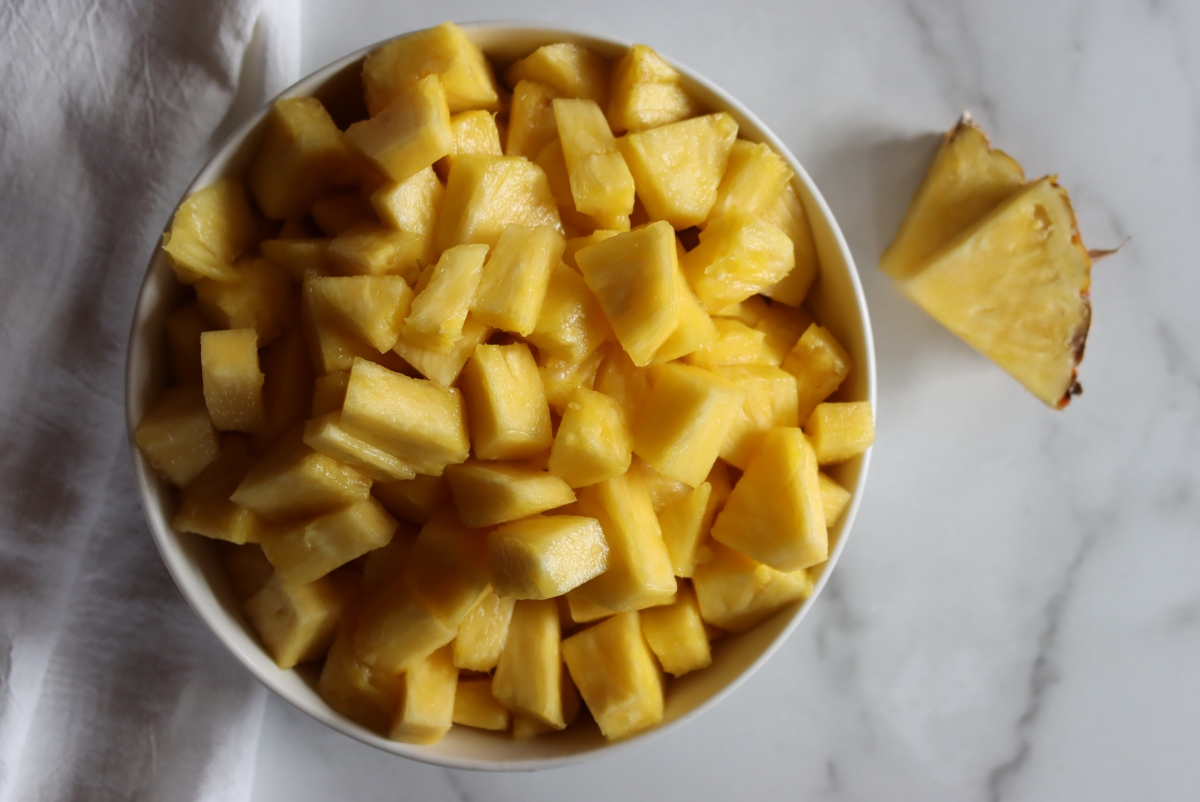
Your second decision is whether or not you’re dehydrating fresh pineapple or cooked pineapple (either blanched in your kitchen or from a can).
I think it has a more fresh flavor if dehydrated raw, but my husband and kids both prefer dried pineapple that has been blanched first. To them, it tastes more “pineapple-y” and has more flavor that way. I think it’s all about your taste buds, so try it both ways and see what you think.
If you do choose to blanch pineapple, you’ll want to dip it in boiling water (or pineapple juice for better flavor) for about 30 seconds before removing it to drain in a colander.
When drying canned pineapple, just chop it into the desired shape and drain the liquid from the can.
Last, you’ll need to decide if you want to sweeten the pineapple (basically making dried pineapple candy). Pineapple is already really sweet, and dried pineapple just concentrates that flavor. You can dust it with sugar before dehydrating if you like, it’s a matter of personal taste.
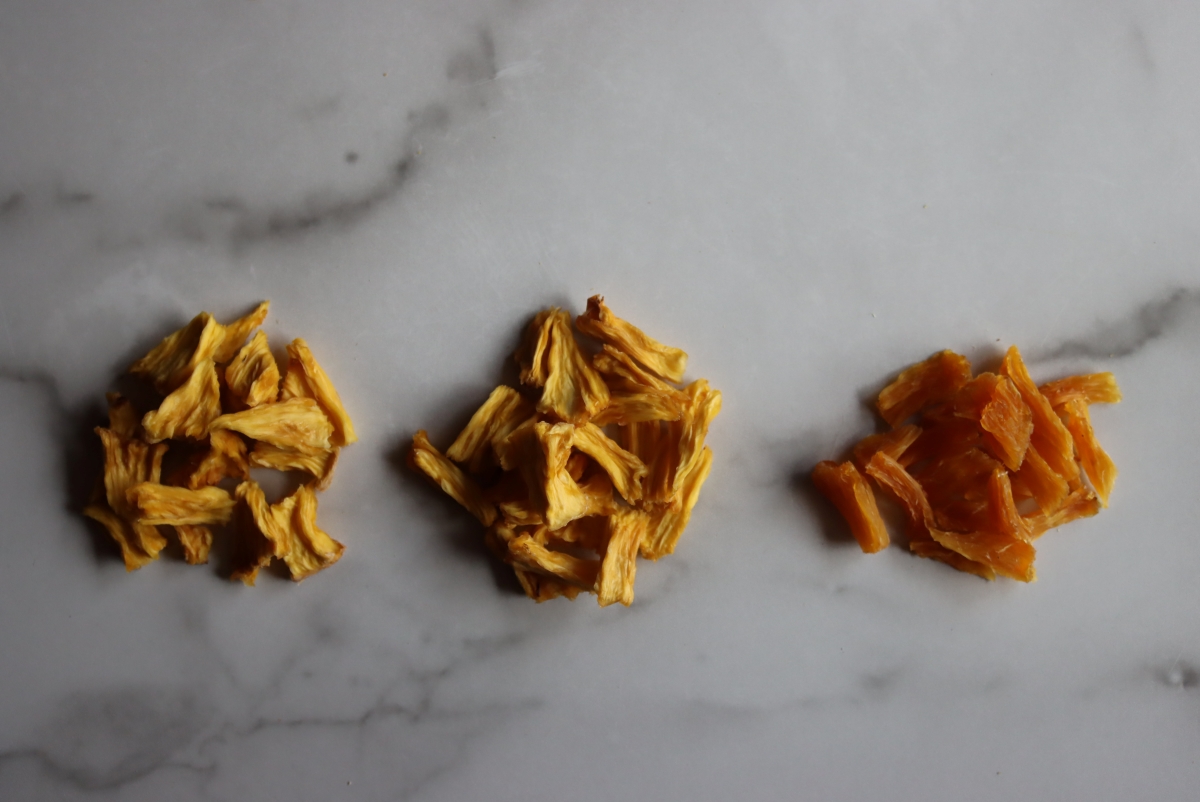
How to Dehydrate Pineapple
Beyond peeling and chopping to your desired size, there’s no other pre-treatment required when dehydrating pineapple. Some sources will tell you that you have to blanch it, but that’s not true. It’s totally optional, and it dries and keeps wonderfully when dehydrated raw.
Other sources will tell you that you need to pre-treat pineapple with lemon juice to prevent it from browning. That’s not true at all (and actually creates pineapple that’s unpalatable acidic in my opinion). Pineapple is naturally very acidic and you shouldn’t have any trouble with browning. Other fruits are actually pre-treated with pineapple juice to prevent browning, so why on earth would you pre-treat pineapple slices with acid? Makes no sense to me.
Simply chop the pineapple into your desired size and shape, and get them on the dehydrator trays (or trays for the oven, if using an oven to dehydrate pineapple).
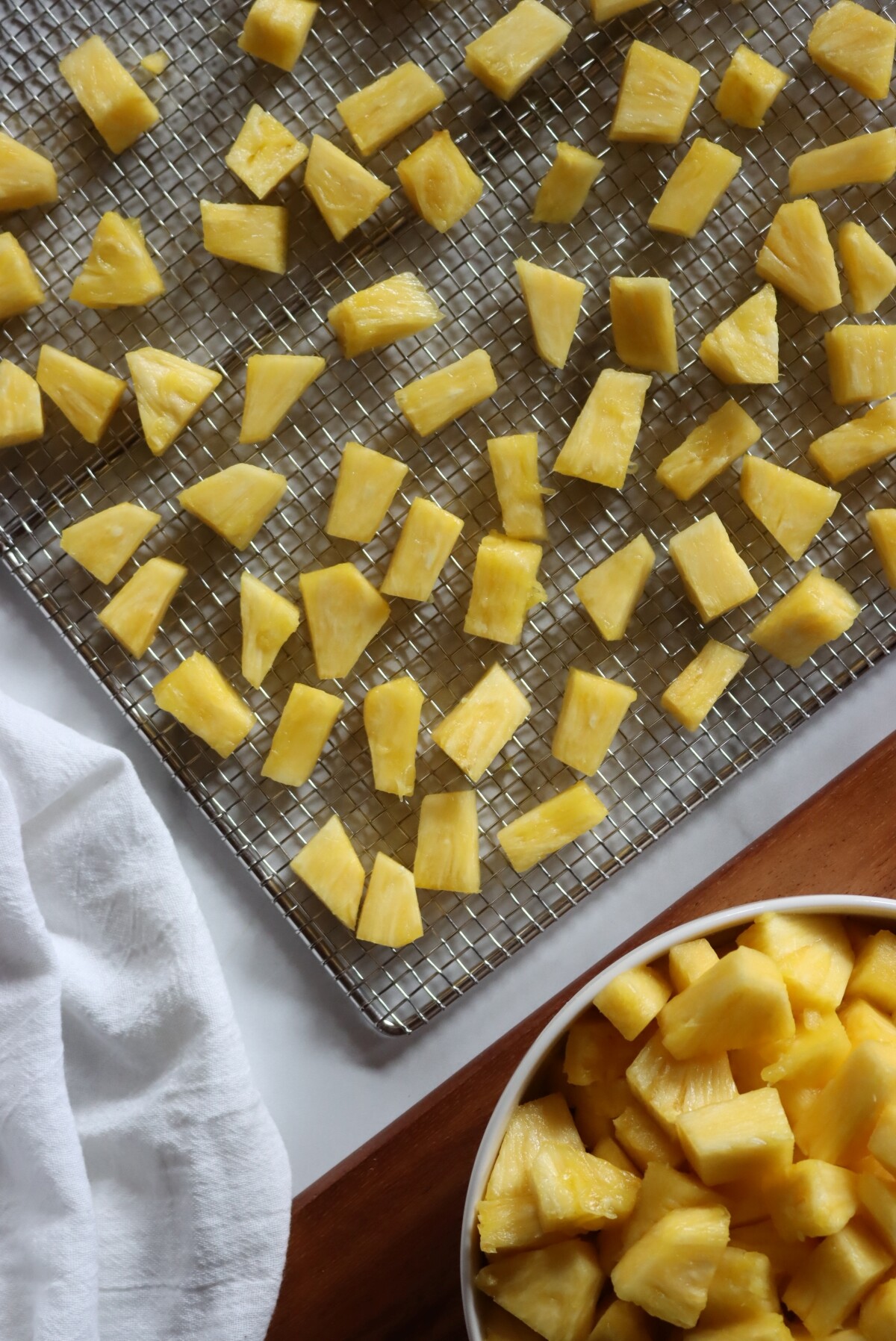
Temperature for Dehydrating Pineapple
Pineapple is usually dehydrated at around 135 to 140 degrees F, as with most other fruits. That’s hot enough to quickly get the dehydration process started before the sugar-rich fruit can spoil.
Any hotter and the pineapple will lose flavor and taste more “cooked.”
Some sources suggest starting the dehydrator at 140 F and running it that way for about 4 hours, then turning it down to 130 F. That’ll quickly bring the dehydrator up to temperature and keep the pineapple from spoiling initially, but then finish the dehydrating at a lower, gentler temperature.
I’d suggest doing that for best quality, but honestly, I never seem to have time to fiddle with it. I’m all about set it and forget it. I set my dehydrator to 140 F for the whole time and it always turns out great.
(If you’re dehydrating pineapple in the oven, you’ll want to set it to the lowest temperature possible. Usually, that’s 170 F in an oven, which is much hotter than you’d want in an ideal world. The pineapple will taste a bit cooked, but it’ll get the job done.)
How Long Does it Take to Dehydrate Pineapple?
Generally, it takes about 10 to 18 hours to dehydrate pineapple in the dehydrator (at 135 to 140 degrees F).
The total time it takes to dehydrate pineapple depends both on how you slice the pineapple (size and shape) and the ambient humidity in the room.
Thicker slices (and bigger pineapple rings) will take longer to dehydrate. Raw pineapple also takes a bit longer to dehydrate than cooked pineapple (canned or blanched). Cooking pops the cell walls a bit, making it easier for the moisture to come out during dehydration.
Humidity also plays a role, and if the ambient humidity is high (like in the summer months), things take a lot longer to dehydrate.
Small pineapple chunks (as I make), with moderate humidity in the room (30 to 50%) generally takes about 10 to 12 hours. Bigger rings in a humid space are going to be more like 16 to 18 hours.
If dehydrating pineapple in the oven, expect it to take about 8 hours for rings (or about 6 hours for small chunks).
Either way, you know pineapple is fully dried when it’s leathery but still pliable. There should be no sticky or spongy areas, and it should feel dry to the touch. It won’t be crisp dry and it shouldn’t break or snap.
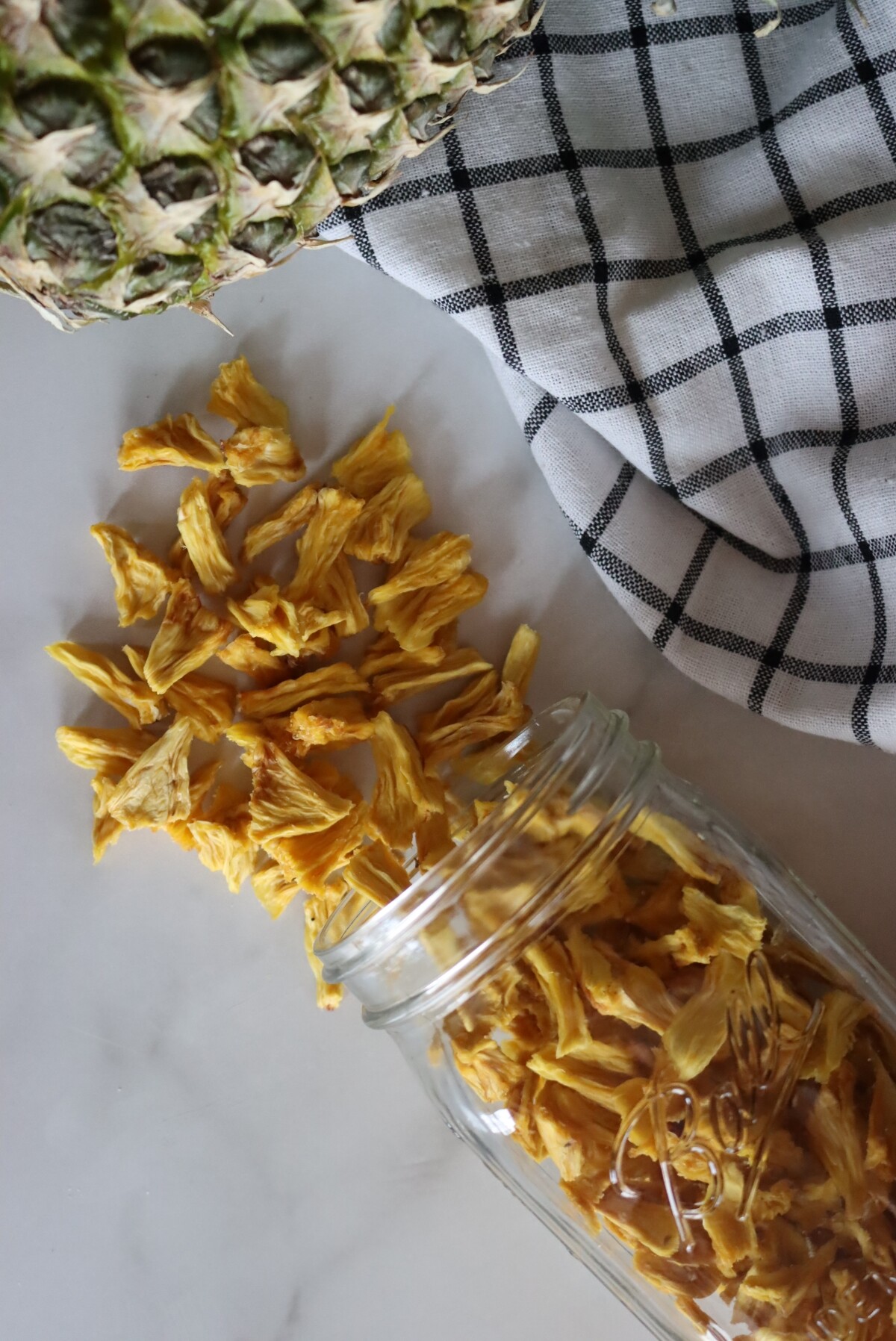
Storing Dried Pineapple
Dried pineapple should be stored in an air-tight container, like a glass mason jar, vacuum sealer bag, or Ziploc bag.
If improperly stored, dried pineapple can absorb liquid from the surrounding air and start to spoil. Be sure it’s kept in a sealed container.
In ideal conditions, in a cool pantry and out of direct sunlight, dried pineapple will maintain peak quality for up to 3 to 5 years. After that, the quality and flavor will start to fade considerably (but it won’t actually spoil so long as it’s still dry).
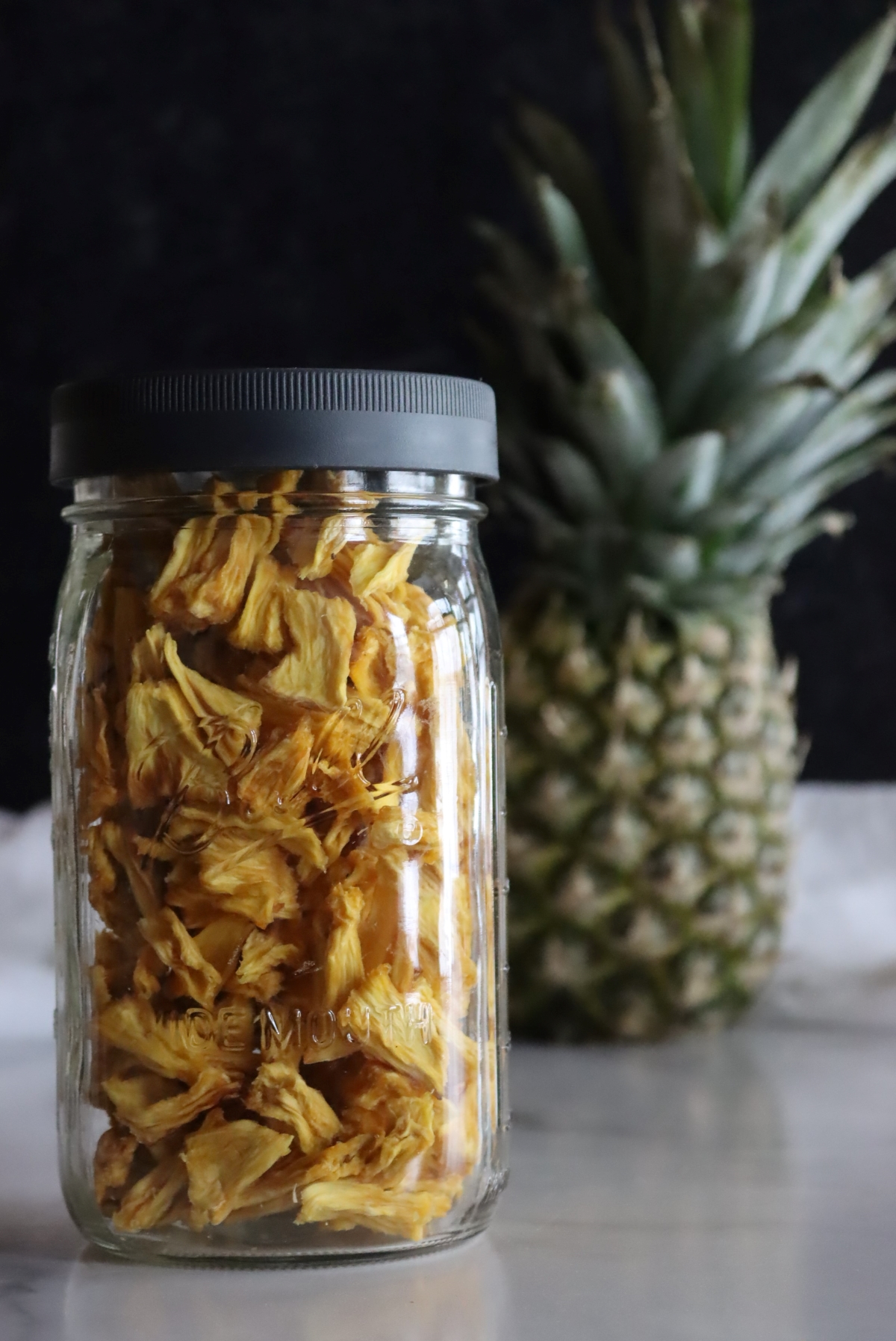
Rehydrating Dried Pineapple
To rehydrate dried pineapple, let is soak in a bowl of room-temperature liquid for 20 to 30 minutes. I don’t suggest hot or boiling water, as that makes a cooked pineapple tea (and a lot of the flavor comes out into the liquid). Hot liquids are fine if you’re going to use the liquid in the recipe too, like if you’re making a Thai curry that uses pineapple.
If you’re just using the rehydrated fruit chunks, use cool or room temperature water and just barely cover the fruit.
I’d suggest using rehydrated pineapple in muffins or carrot cake, added to oatmeal or in curries or stir-fries. It’s also good just eaten as a rehydrated snack.
Dried pineapple (not rehydrated) is great to add to trail mix, granola, or just eat as a quick (and tasty) snack.
Ways to Preserve Pineapple
Looking for more ways to preserve pineapple?
- Canning Pineapple
- Pineapple Jam
- Pineapple Wine
- Freezing Pineapple
- Tepache – Fermented Pineapple Drink
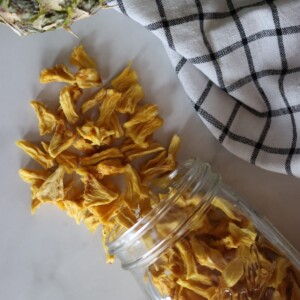
Dehydrating Pineapple
Ingredients
- Pineapple, fresh or canned
Instructions
- Prepare the pineapple by first peeling and coring, then slicing into your desired shape. Rings or small chunks work well. (If using canned pineapple, just slice into your desired shape.)
- Arrange pineapple on dehydrator trays (or oven trays if dehydrating in the oven).
- Dehydrate pineapple at 135 to 140 degrees for 10 to 18 hours in a dehydrator. Rings take a bit longer than small chunks.
- If using an oven to dehydrate, set the oven as low as it will go (usually 170 F) and dehydrate for 6 to 8 hours, flipping every few hours to encourage even dehydrating.
- Pineapple is fully dehydrated when it's leathery and pliable, with no sticky or spongy areas. It should be dry to the touch.
- Store dried pineapple in an air tight container. Ideally in a cool location out of direct sunlight.
Dehydrator Recipes
Need a few more easy dehydrator recipes?
- Dehydrating Carrots
- Dehydrating Mushrooms
- Dehydrating Apple Slices (coming soon)
- Dehydrating Kiwi (coming soon)
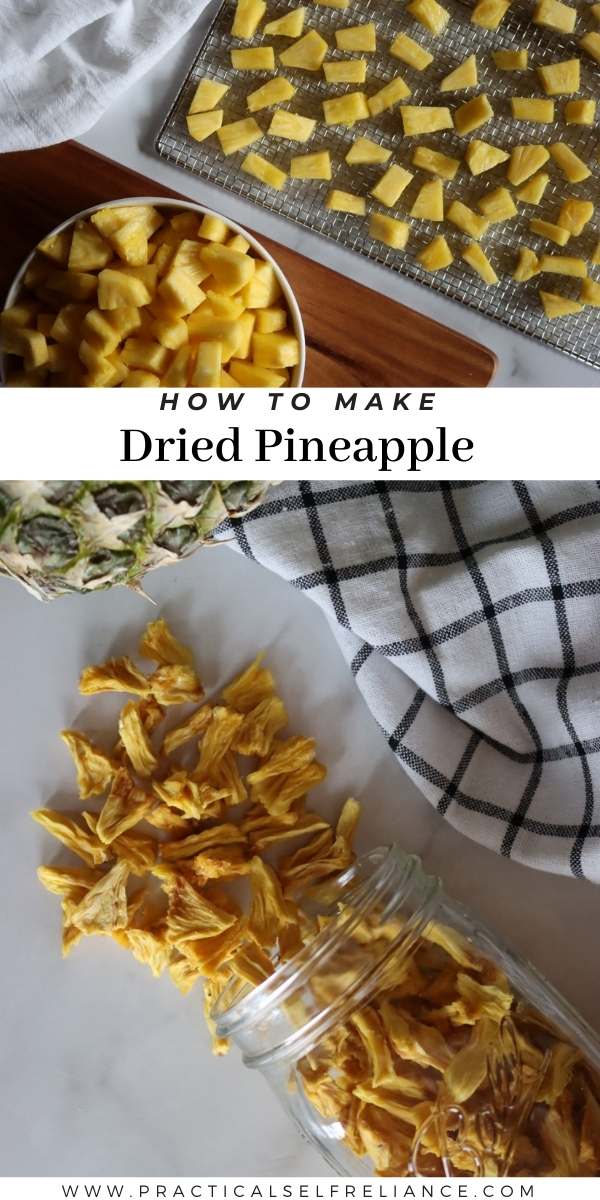
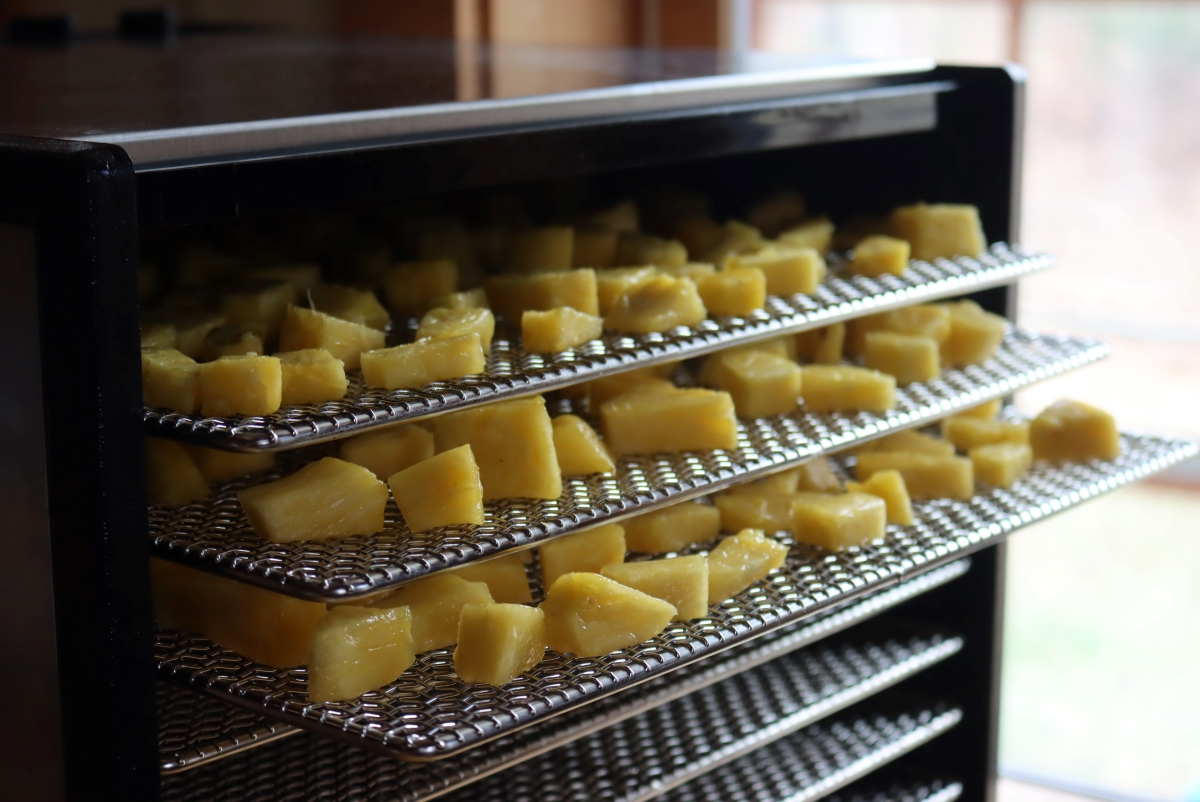
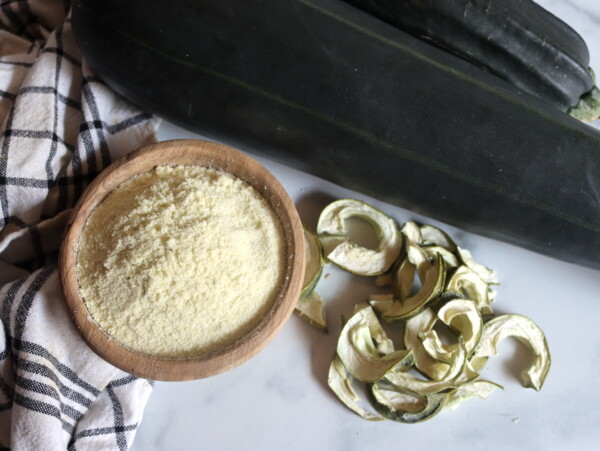
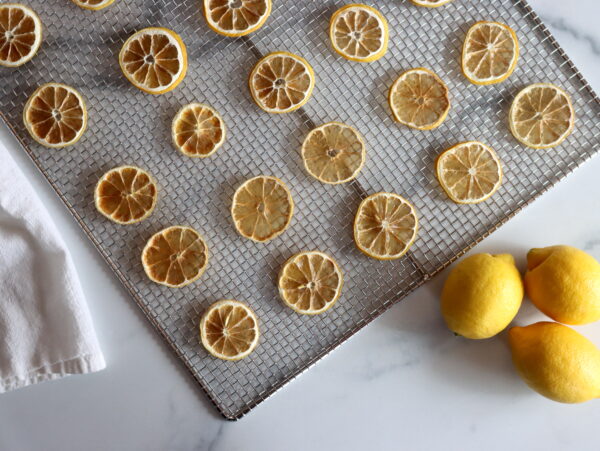
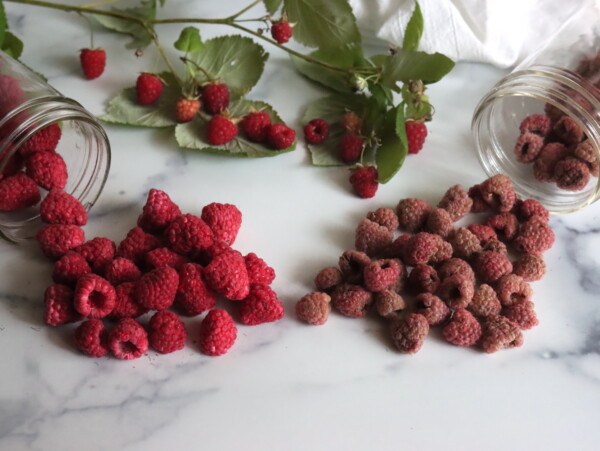
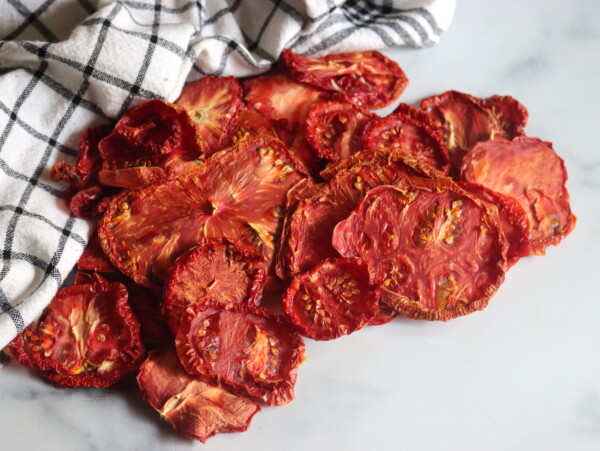
Thanks for your dehydrating Pinaple lesson. let me know of other things that I can dehydrate
You’re quite welcome!
I have a long list of dehydrator recipes here: https://practicalselfreliance.com/dehydrator-recipes/